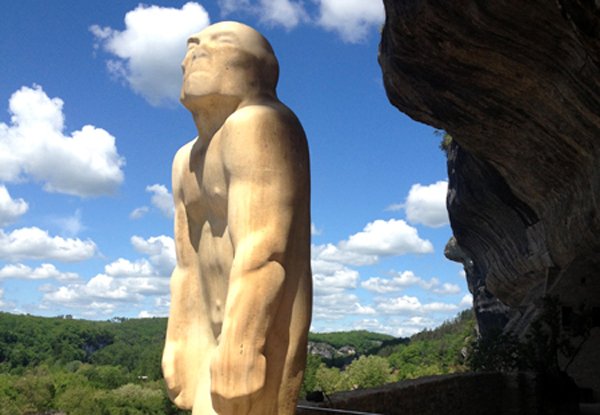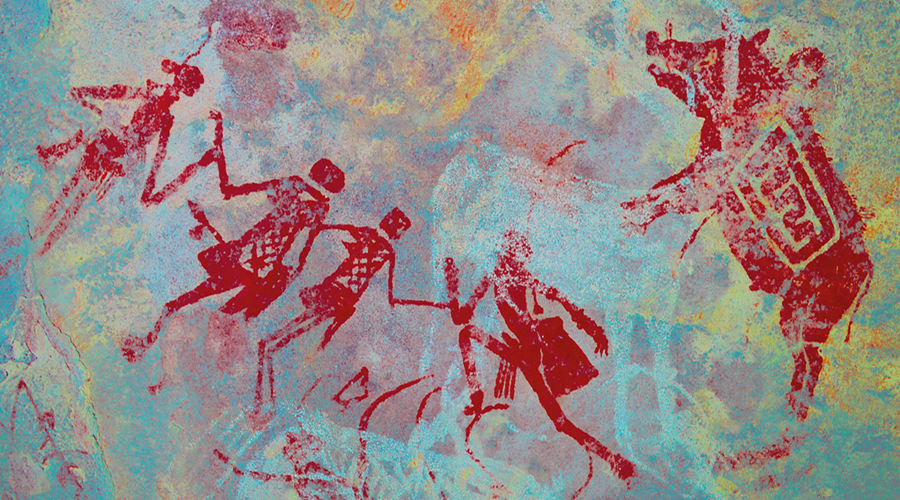



This month I was invited to join the Dordogne Rock Art Field Trip in France to view the decorated caves, organised by Dr Didier Bouakaze-Khan, Senior Lecturer and Coordinator of MA Rock Art Studies courses at the Institute of Archaeology, University College London (UCL). The Field trip was arranged in conjunction with Centre National de Prehistoire (CNP) and the French Ministry of Culture and Communication, and hosted by Jean-Michel Geneste and Catherine Cretin. Jean-Michel Geneste is currently heading the research and conservation of both Chauvet and Lascaux.

The field trip was based in the small town of Les Eyzies de Tayac, the home of the National Museum of Prehistory, with an extensive display of Palaeolithic artefacts including the bison carving of La Madeleine and the Lascaux oil lamp. The museum also has a number of excellent film displays showing the use of lithic tools for a variety of purposes. During the field trip, the museum hosted two days of seminars: 4emes Rencontres d'art rupestre 'Thinking Contexts in Rock Art: Methods, Experiences, Prospects' featuring international researchers on rock art. The seminars involved a wide range of presentations on current international research, including 'Interdisciplinary approach to the relative chronology of rock art sites : Genyornis occupation site, Arhnem land, Australia' by Jean-Michel Geneste, and 'The Tsodilo Hills of Botswana: Rock Art at the Lascaux of the Kalahari - Lecture in memory of Alec Campbell' by Didier Bouakaze-Khan.
The field trip participants included Professor Stephen Shennan (Director of the Institute of Archaeology at UCL), Ethan White (IoA MA student), Kate Sinha (IoA MA student), Ginger Drage (IoA MA student) and Dr Maria Guagnin (Edinburgh alumni and specialist in Saharan rock art).

The Caves
We were extremely privileged to spend 4 days visiting the decorated caves, under the guidance of Catherine Cretin, Jean-Christophe Portais and Emilie Lesvignes.
The caves are heavily concentrated in this region, yet each cave is distinctive in its geology and its art. The variety of rock art is impressive, from engravings to finger fluting, from monochrome drawings to polychrome paintings. The rock art consisted almost entirely of animal imagery, including mammoths, woolly rhinoceroses, lions, cave bears, bovids, horses, megaloceroses and ibex. There are also numerous hand stencils and geometric symbols, painted and engraved. There are very few human representations. A common feature of the rock art was the use of the cave wall surface, the natural relief of the rock, to enhance the shape of the image - the head of a mammoth, the sloping back of a bison. Another feature was the importance of the angle of light; from one position the carving was undetectable, from another, most striking. For many of the caves, the desire of the artists to penetrate to the very end was evident - to crawl in to the final recess to paint.
The rock art varies in age, from the Gravettian to the Magdalenian; from the 24,000 year old paintings of Cougnac and Peche Merle, to the 18,000 year old paintings of Lascaux, to the 17,000 year old polychrome paintings of Font-de-Gaume, to the 16,000 year old carvings of Cap-Blanc.
The sites visited included Domme - our first mammoth - Pigeonnier - bovids and horses - Roc de Vezac - black and red hand stencils and engraved symbols - Grotte du Roch - a small solitary horse - La Calevie, and Vallons des Charbonnieres. Next, Abri du Poisson with its life-size carved salmon on the ceiling, and Combarelles with over 600 paintings and engravings. We also visited the 'text book' archaeological site of Abri Patau in Les Eyzies de Tayac, dating back to 34,000 years. Font-de-Gaume cave revealed spectacular Magdalenian polychrome paintings and engravings, over 200 in number, with its main gallery of bison, as well as reindeer, mammoths, horses and a few stylised human figures. The Cap-Blanc rock-shelter consists of a wide panel of life-size carved - infact sculpted - horses, one of which is over 2 metres long.
Lascaux Cave is now closed to the public, but a memorable experience of the paintings is possible with Lascaux II, an exact replica of part of the original cave. We were also able to visit the Lascaux conservation control room, essentially a life-support system controlling the air, temperature and humidity of the cave. The cave is now stable and the paintings are safe.
Rouffignac is an impressive cave - vast and slowly descending, not unlike a motorway tunnel. Majestic intermittent panels of black mammoth drawings and engravings gradually move from the walls to the ceiling as the cave height reduces, coexisting with the multitude of cave bear pits used for hibernation, until the end of the cave is reached with a dizzying display of drawings including woolly rhinoceroses, mammoths, horses and ibex. These would have been drawn lying down.
Finally, Peche Merle with the famous horse panel, and Cougnac cave, dominated by stalagmites and stalactites, with impressive red paintings of megaloceroses and ibex, and enigmatic human-like figures.
The Dordogne is an epicentre of Palaeolithic rock art, and the scientific research and conservation here are second to none. So my thanks to Didier Bouakaze-Khan and Jean-Michel Geneste, among many others, for allowing me to experience this.
Peter Robinson, Editor
by Bradshaw Foundation
Monday 30 May 2022
by Bradshaw Foundation
Wednesday 19 January 2022
by Bradshaw Foundation
Thursday 06 January 2022
by Bradshaw Foundation
Monday 06 December 2021
by Bradshaw Foundation
Monday 29 November 2021
by Bradshaw Foundation
Monday 25 October 2021
by Bradshaw Foundation
Monday 12 July 2021
by Bradshaw Foundation
Monday 24 May 2021
by Bradshaw Foundation
Tuesday 20 April 2021
by Bradshaw Foundation
Thursday 01 April 2021
by Bradshaw Foundation
Tuesday 23 February 2021
by Bradshaw Foundation
Thursday 14 January 2021
by Bradshaw Foundation
Friday 18 December 2020
by Bradshaw Foundation
Sunday 06 December 2020
by Bradshaw Foundation
Thursday 26 November 2020
by Bradshaw Foundation
Wednesday 07 October 2020
by Bradshaw Foundation
Monday 30 May 2022
by Bradshaw Foundation
Wednesday 19 January 2022
by Bradshaw Foundation
Thursday 06 January 2022
by Bradshaw Foundation
Monday 06 December 2021
by Bradshaw Foundation
Monday 29 November 2021
by Bradshaw Foundation
Monday 25 October 2021
by Bradshaw Foundation
Monday 12 July 2021
by Bradshaw Foundation
Monday 24 May 2021
by Bradshaw Foundation
Tuesday 20 April 2021
by Bradshaw Foundation
Thursday 01 April 2021
by Bradshaw Foundation
Tuesday 23 February 2021
by Bradshaw Foundation
Thursday 14 January 2021
by Bradshaw Foundation
Friday 18 December 2020
by Bradshaw Foundation
Sunday 06 December 2020
by Bradshaw Foundation
Thursday 26 November 2020
by Bradshaw Foundation
Wednesday 07 October 2020
Friend of the Foundation











